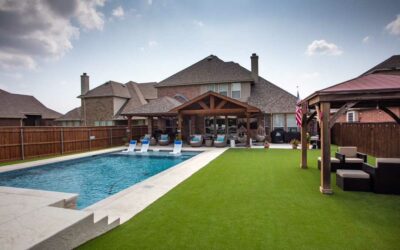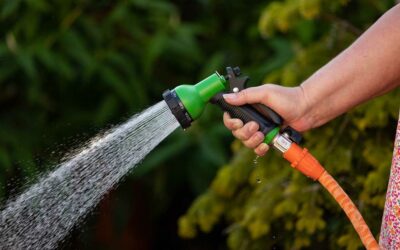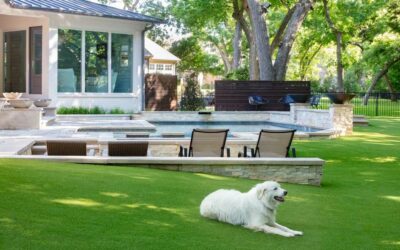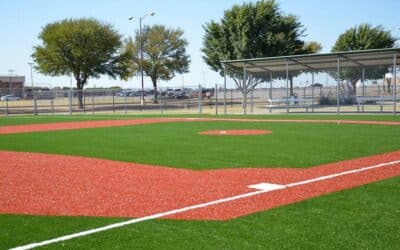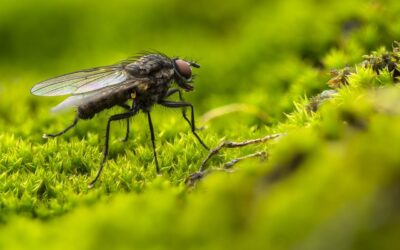Does your artificial grass lawn stink of dog pee?
That was not what you expected when you chose to replace natural grass with turf, was it?
If your pet turf was installed by professionals with the correct drainage, infill, and other precautions taken during installation, you should have few worries with artificial grass stinking of dog pee. It’s generally very pet-friendly.
But some homeowners cut corners, use inferior grass, skip important measures during installation or neglect maintenance, leading to unpleasant odors collecting on or below the grass from dog waste, especially in hot weather.
Here’s what you need to know about pet turf and how to remove any unwanted smells…
Is Artificial Grass Suitable For Dogs?

Over 65 million households in the U.S. own a dog, so finding backyard setups that are dog-friendly is a major consideration for many homeowners.
Fortunately, synthetic grass is well suited to pets and dogs can pee on artificial grass the same as they would on real grass.
In fact, there are many benefits of switching from real grass to artificial grass if you have dogs. That’s why many dog parks, dog runs, pet hotels, and other pet-related places use artificial grass.
The lack of maintenance is one major plus., But there are other benefits of switching from natural grass if you have dogs. Most notably:
- No muddy paws trailing through the house
- Cleaner dogs = fewer doggy baths
- No digging up your prized lawn
- No yellow stains
- No grass trimmings in the house
- Fewer bugs and fleas
- Fewer odors
- Toxin-free (no pesticides or fertilizers)
It’s not all benefits. There are pros and cons of artificial grass if you have dogs, For instance, artificial grass tends to get hotter than real grass in summer. But that can be remedied if you choose the right grass and, besides, the main caveat to the benefits is how the pet turf is installed.
The installation needs to be professional and a few extra precautions taken above and below the layer of turf if it’s going to be used regularly by dogs. We deal with this in a later section.

Why Does Your Artificial Grass Stink Of Dog Pee?
The smelly component of urine, whether human or canine, is urea or uric acid. This is one of the body’s waste products, used to break down amino acids. Dogs, like humans, need to expel this as urine to prevent a toxic buildup in the body.
Urine residue slowly releases ammonia back into the air over time and the uric acid doesn’t naturally decompose over time. This is the main reason for the overpowering smell that is so unpleasant for homeowners and that may not dissipate unless you address the issue.
Under normal circumstances, the dog pee drains well away from your artificial grass. However, if your dog urinates in the same area every day or you have large dogs in a small area and some aspects of installation or maintenance have been neglected, this can create a stink.
Your artificial grass could stink of dog pee because of any of the following reasons:
- Poor drainage due to poor-quality grass or sub-standard installation (high-quality, professionally installed pet turf should be able to handle all the fluids your dog(s) can throw at it, as well as the elements).
- Lack of permeability in the backing of the turf: this is often a feature of lower-quality turf or turf that uses absorbent latex backing rather than polyurethane, which is non-absorbent and washable.
- The use of poorly placed membranes under the turf interrupts the flow of liquids away from the grass and, instead, gathers and collects bacteria.
- A buildup of urine in other “layers” underneath the turf due to poor installation.
- Poor use of infill on the grass: infill is used to keep the artificial grass blade standing upright and looking realistic but if you have dogs, a special non-sand-based antimicrobial infill can be used
- Lack of maintenance: artificial grass is low-maintenance compared to real grass but there are several tasks you should do regularly if you have dogs to avoid urine buildup.

The problem is often worse in the summer or when a lack of rainfall flushes the dog pee away. High temperatures and humidity exacerbate the smell, which can be overpowering if the dog pee doesn’t drain away or isn’t neutralized properly.
A stinking backyard is not what you signed up for when you made the switch to artificial grass!
After all, the upfront cost of artificial grass is higher than real grass and you likely installed your backyard lawn to enjoy with your family without having to spend hours on upkeep. If it’s reeking of dog pee all the time, you may be doubting the investment you made—and rightly so!
Here’s what you can do about it…
5 Tips For Neutralizing Dog Pee Odors
If your artificial grass stinks of dog pee due to poor installation, taking the usual steps to clean artificial grass, such as spraying the area with water may not be effective. You’ll simply move the trapped urine around, which will do little to remove the smell.

The same goes for a high-pressure hose, which may help you blast some of the smell away but you would need to do this quite regularly in the hotter months to be effective. That’s not great news for areas experiencing water shortages.
Short of ripping up your turf, preparing the ground properly under the turf, and reinstalling it, then, what measures can you take to neutralize dog pee odors?
Use A Good Enzyme-Based Cleaner
Enzyme-based cleaners are more powerful than traditional cleaning liquids.
Because uric acid is not water-soluble, water alone won’t help you eliminate the odors. If you use a solution containing enzymes and live bacteria, it will tackle the root cause of the problem, breaking down the acid causing the pungent smells and getting rid of the odors.
Most enzyme cleaners can be hooked up to a garden hose and combined with water to soak the artificial grass area. No brushing or scrubbing should be required. Simply rinse away afterwards. Don’t forget to follow the directions on the cleaner’s container.

Change The Infill
The infill for artificial grass is a “dressing” usually made from crumb rubber, sand and/or silica granules. Pet owners should use a sand-free, antimicrobial infill. This will prevent ammonia and bacteria from being trapped and nasty pet pee odors from developing.
An infill with anti-microbial and anti-bacterial properties is essential for maintaining a sanitary artificial grass space that controls germs and odors. If you’re unsure what type of infill is on your grass but you’re experiencing pungent odors, it may be a raw sand-based infill that traps the urine smells.

To change the infill, you’ll need to vacuum out all of the old infill, remove all the gunk, and clean the area using an enzyme-based cleaner (described above), before adding the new antimicrobial infill. Don’t skimp on infill amounts—a minimum of two to three pounds of infill per square foot.
You can sprinkle the infill on the artificial grass and brush it in with a plastic leaf rake or power brush.
Try A Commercial Disinfectant
A heavy-duty, broad-spectrum disinfectant will get rid of your dog pee smells and most other bacteria and nasties—but you may find the smell of the disinfectant quite strong, creating another unwanted odor.

Zoflora products contain fragrance so they leave a perfumed smell behind on your grass after cleaning and disinfecting an area with the offensive smells. You dilute these disinfectants in water and they should be effective at neutralizing dog pee odors.
Apply Diluted White Vinegar
You can try spraying white vinegar diluted in equal parts with water on the artificial grass area and leaving it for about 10 minutes. Then, rinse the area with a hose.
This should neutralize the pet pee odor temporarily. However, the smells could return—and you’ll also have to deal with a strong vinegary smell for a time.
Sprinkle With A Deodorizer
After cleaning, you may want to sprinkle a natural turf deodorizer, such as baking soda, on the affected area. Let it sit on the turf for 20 minutes before sweeping or vacuuming.
The problem with this approach is that the infill will also be cleared away so only sprinkle baking soda if you plan to change the infill afterwards.

Buyer Beware!
Hundreds of cleaners are available online, many promising to remove the smell of urine from various surfaces. Buyers should beware of products that overpromise as many do not deliver what they claim. Often, they cover up the smell or “mask it” with another odor so that after a few days, the urine smell returns.
The best way to neutralize pet pee odors is to tackle the root causes. That means disinfecting the area, breaking down the uric acid crystals in the urine, and/or addressing structural issues with how the artificial grass was installed.
With any commercial cleaning product, be sure to carefully check instructions before usage and follow them closely. If in doubt, you might want to test a small area of your artificial grass first before treating the entire area. Rinse the area thoroughly with water afterward.

Note that if you have more than one large dog and/or a small lawn, getting rid of the pet pee odor can be more challenging due to the sheer concentration of urine. Ideally, this should be considered upfront when you make the switch and install your grass. Two or more large dogs in any small grass space are likely to be a challenge.
What Should You Put Under Pet Turf?
How do you know if your pet turf installation is to blame for your dog pee odors?
Well, that can be tough to pinpoint but if you’ve tried various cleaning methods and changing infill but the pee odors keep returning, it’s time to go deeper.
For a truly dog-friendly lawn area, a deodorizer layer should be installed below the compacted sub-base layer of aggregate and granite dust. This is an additional step missed by some installation companies that attempt to cut corners and save on costs.
At the beginning of the quotation process, we check with homeowners about pets using the space and this will be factored into the installation costs. We advise every homeowner with pets to install this deodorizing layer.
Other important steps when installing artificial grass for pet owners include choosing a suitable turf, preparing a professional sub-base layer that allows pee to drain away, adding antimicrobial infill, and NOT installing a weed barrier.

Some installations aim to prevent weeds by installing a membrane below the grass that will simply trap the pet urine and prevent it from draining away. To prevent weeds, use a non-toxic weedkiller instead.
If you use a membrane below your artificial turf, this should be a high-quality membrane with a mat backing—and it should be placed underneath the foundations of the turf rather than directly under it, as with a weed barrier.
Essential Maintenance For Artificial Grass With Dogs
Compared with real grass, synthetic turf is ultra-low maintenance. There’s never any cutting, trimming, watering, aerating or fertilizing but if you’ve got pets, there are a few essential steps to take care of periodically.
These steps will help keep the lawn looking and smelling new and fresh:
- Rinse the turf with water from time to time (once a month at a minimum but once a week is even better).
- Remove solid waste as soon as possible.
- Apply an enzyme-based cleaner or disinfect it periodically if urine smells start to develop
- Top up the infill and ensure an even coverage by raking it using a rubber-pronged rake or a nylon brush.
- Remove the old infill and replace it periodically as required.
- Remove debris by hand to avoid insects and bacteria buildup.
The more dogs you have, the more often you’ll need to perform these basic maintenance steps, especially if the dogs are larger breeds. You’ll need to work a little harder in the hotter, drier months when rainfall doesn’t help to wash the unwanted odors away.
The good news is that your work should prevent your artificial lawn from stinking of dog pee!

FAQs
Can You Use Bleach On Artificial Grass?
No, undiluted bleach should not be used on artificial grass as it can cause discoloration and other damage.
How Do You Remove Solid Waste From Artificial Grass?
Remove solid waste from artificial grass as soon as possible as you would with real grass. Collect the waste with a bag or scoop, rinse the area with water, apply a disinfectant cleaner, and then rinse with water again.
Can Dog Pee Cause Yellow Staining On Artificial Grass?
Artificial grass is highly durable and will not discolor with dog pee.
What Type Of Backing Should My Turf Have?
Avoid latex backing as this will cause the artificial grass to retain dog pee. The best pet turf comes with polyurethane backing which is non-absorbent and can be easily washed.

Customized Dog Areas With Artificial Grass…
Preventing the stink of dog pee with the right artificial turf, professional installation, and some basic general maintenance is the best way to deal with the threat of odors if you have dogs.
However, if the turf is already installed and you’re noticing a stink, the above steps should help you understand and remedy the problem.
Our experienced team of turf professionals has helped homeowners with dogs enjoy customized, picturesque, odor-free areas in their front and back yards. If you’re considering the switch to turf, discuss your options with an artificial grass professional.

